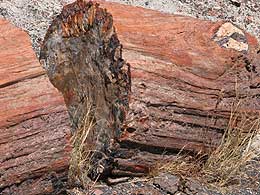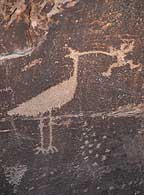Puerco Pueblo
 |
 |
Petrified Forest National Park
This high, dray tableland was once a vast flood plain crossed by many streams. Tall, stately pine-like trees grew along the headwaters. Crocodile-like reptiles, giant amphibians, and small dinosaurs lived among a variety of ferns, cycads, and other plants and animals that are known only as fossils today. The tall trees--Araucarioxylon, Woodworthia, and Schilderia--fell and were washed by swollen streams into the floodplain. Silt, mud, and volcanic ash then covered the logs. This blanket of deposits cut off oxygen and slowed the decay of the logs. Silica-laden groundwater seeped through the logs and replace the original wood tissues with silica deposits. As the process continued, the silica crystalized into quartz, and the logs were preserved as petrified wood.
That was about 225 million years ago in the Late Triassic Period. After that time, the area sank, flooded, and was covered with freshwater sediments. Later the area was lifted far above sea level, and this uplift created stresses that cracked the giant logs. Over time, wind and water have worn away the layers of hardened sediments, exposing the fossilized remains of ancient plants and animals. The hills will continue to yield fossil treasures as ceaseless weather patterns sculpt the soft clay soils of the Painted Desert.
There are many stories here in the Petrified Forest. Evidence of early human occupation is readily visible on the landscape. Sites throughout the park tell of human history in the area for more than 10,000 years. We do not know the entire story, but wandering families to settled agricultural villages--or pueblos--and trading ties with surrounding villages. Although evidence of these early people fades about 1400, their story remains through their dwellings, pot sherds, and petroglyphs.
In the mid-1800s U.S. Army mappers and surveyors exploring this area carried stories back East of the remarkable "Painted Desert and its trees turned to stone." Next, pioneers, ranchers, and sightseers made their way into the area. After a period of using the wood for souvenirs and many commercial ventures territorial residents recognized that the supply of petrified wood was not endless. In 1906 President Theodore Roosevelt set aside selected "forests" as Petrified Forest National Monument. In 1932 53,200 more acres of the Painted Desert were bought and added to the monument, and in 1962 the monument acquired national park status. In 1970 50,000 acres in the park became the first designated wilderness in the National Park System. Research continues to unlock the geological and human stories set aside for present and future generations.
(Much of the information in this section was adapted from resources provided by the National Park Service.)